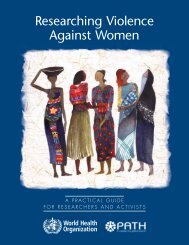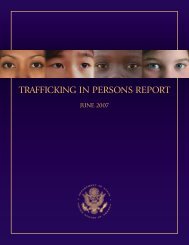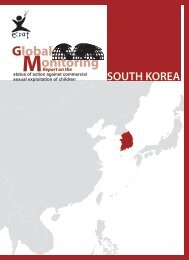Download PDF - Violence Against Children - East Asia and the ...
Download PDF - Violence Against Children - East Asia and the ...
Download PDF - Violence Against Children - East Asia and the ...
You also want an ePaper? Increase the reach of your titles
YUMPU automatically turns print PDFs into web optimized ePapers that Google loves.
Indonesia<br />
An integrated approach<br />
A range of approaches can assist in building a<br />
safer world for Indonesia’s children.<br />
Cooperative, ra<strong>the</strong>r than competitive,<br />
relationships between agencies is vital,<br />
especially those that implement programs<br />
with similar approaches – as with World<br />
Vision <strong>and</strong> UNICEF in North Maluku. World<br />
Vision <strong>and</strong> UNICEF plan to conduct a joint<br />
in-depth education assessment as part of a<br />
planned initiative.<br />
Cooperation is also developing around<br />
education projects in North Maluku with<br />
Save <strong>the</strong> <strong>Children</strong> UK. This agency can offer<br />
educational expertise, training <strong>and</strong><br />
government policy work related to its overall<br />
strategy for developing alternative peaceoriented<br />
curriculums with <strong>the</strong> Ministry of<br />
Education. World Vision contributes in <strong>the</strong><br />
areas of community organisation, peace<br />
building <strong>and</strong> trauma support at <strong>the</strong><br />
community level.<br />
Save <strong>the</strong> <strong>Children</strong> places emphasis on<br />
linking advocacy to field practice, <strong>and</strong> has a<br />
clearly articulated approach. Partnership<br />
between World Vision <strong>and</strong> Save <strong>the</strong> <strong>Children</strong><br />
UK is important in West Kalimantan on issues<br />
affecting IDPs <strong>and</strong> in giving information on<br />
child protection to <strong>the</strong> provincial<br />
government. Save <strong>the</strong> <strong>Children</strong> also has<br />
valuable experience <strong>and</strong> resources on<br />
approaches to peace education. This includes<br />
child-to-child (C2C) modules involving<br />
children from different ethnic groups<br />
discussing issues on child rights <strong>the</strong>mes.<br />
Partners in this process<br />
In West Kalimantan, Save <strong>the</strong> <strong>Children</strong> <strong>and</strong><br />
World Vision have worked toge<strong>the</strong>r in<br />
establishing an NGO coalition, including local<br />
NGOs, with <strong>the</strong> main objective of<br />
establishing a forum where children’s issues<br />
<strong>and</strong> common concerns can be addressed <strong>and</strong><br />
where mutual acceptance can be promoted.<br />
This coalition has been acknowledged by<br />
local government.<br />
In a separate program in West Kalimantan,<br />
Save <strong>the</strong> <strong>Children</strong> brings children from<br />
different ethnic <strong>and</strong> religious backgrounds<br />
toge<strong>the</strong>r to present a radio program for<br />
children by children. <strong>Children</strong> are able to get<br />
several free hours of airtime a week. This is<br />
broadcast in <strong>the</strong> capital (Pontianak) <strong>and</strong> taped<br />
for use in o<strong>the</strong>r areas, with a total coverage<br />
of over 1 million people. There are plans to<br />
extend on this model as it gives an avenue to<br />
promote children’s right to speak on issues<br />
that affect <strong>the</strong>m, <strong>and</strong> to influence community<br />
public debate on such issues, as well as<br />
promoting mutual acceptance. It is costeffective,<br />
engages children, <strong>and</strong> is transferable<br />
to o<strong>the</strong>r contexts where <strong>the</strong>re is potential to<br />
profile children’s issues in a range of media to<br />
transform communities into ones that protect<br />
<strong>the</strong>ir children.<br />
Approaches that involve child participation<br />
linked to schools are in keeping with existing<br />
community development objectives. Local<br />
contact with schools both streng<strong>the</strong>ns<br />
educational institutions <strong>and</strong> enables child<br />
protection matters to be considered at policy<br />
level. The approach is long-term <strong>and</strong> can be<br />
integrated into curriculums. Where areas<br />
have been affected by violence <strong>and</strong> relief<br />
operations are in place, this approach can be<br />
used as part of a transition from relief to<br />
development programming (although, it<br />
should be noted, instability may return).<br />
Useful curriculum resources are available<br />
from UNESCO, which has developed an<br />
extensive resource for grades 1– 8 from its<br />
work in Africa.<br />
Impact of <strong>the</strong> project<br />
The importance of access to quality<br />
education was expressed many times by <strong>the</strong><br />
children, community leaders <strong>and</strong> parents<br />
alike. A program supporting education is<br />
<strong>the</strong>refore also a gateway to broadening<br />
community response to issues that limit <strong>the</strong><br />
future of <strong>the</strong>ir children.<br />
53

















